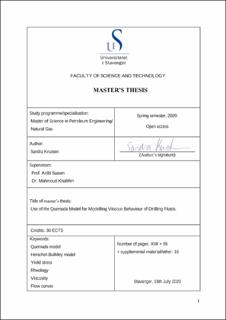| dc.contributor.advisor | Saasen, Arild | |
| dc.contributor.advisor | Khalifeh, Mahmoud | |
| dc.contributor.author | Knutsen, Sandra | |
| dc.date.accessioned | 2020-11-18T09:51:01Z | |
| dc.date.available | 2020-11-18T09:51:01Z | |
| dc.date.issued | 2020-07-15 | |
| dc.identifier.uri | https://hdl.handle.net/11250/2688408 | |
| dc.description | Master's thesis in Petroleum Engineering | en_US |
| dc.description.abstract | Drilling fluids are essential for drilling operations and serve many important functions. To maintain control of the wellbore, while ensuring sufficient cutting transportation, good understanding of the rheological properties and behaviours of drilling fluids are required. The rheological behaviours of drilling fluids are often unknown for the relevant range of shear rates, making available models a necessity when simulating their rheological behaviour. Traditionally, the drilling industry uses simple models when simulating the viscosity profile of drilling fluids, e.g. Herschel-Bulkley or Power Law. However, the accuracy of these models can be questioned. Therefore, this study investigated the use of the Quemada model for modelling viscous behaviour of drilling fluids, while the Herschel-Bulkley model was used to serve as a basis of comparison.
The shear stress/shear rate relationship was measured by OFITE Model 900 and Anton Paar MCR 302 to analyse the fluid properties and behaviours. The drilling fluids were also exposed to simulated well conditions (elevated temperatures and dynamic ageing) to characterise their rheological change. The Herschel-Bulkley model curves were fitted with nonlinear regression by reducing the residual sum of squares (RSS), where the shear rate range had to be limited to 0.0511-287 s-1 to improve model accuracy. This resulted in models able to describe the characterised rheological behaviours of the drilling fluids with decent accuracy. The Quemada model was curve fitted for the entire measured shear rate range of
0.0511-1020 s-1 with nonlinear regression by using the weighted least square (WLS) method. Additionally, the infinite- and zero-shear viscosities were treated as curve fitting values. This yielded one highly accurate solution for all viscosity profiles, where most of the curves had indications of the infinite- and zero-shear plateaus due to the extensive shear rate range. This resulted in good estimations of the infinite- and zero-shear plateaus. | en_US |
| dc.language.iso | eng | en_US |
| dc.publisher | University of Stavanger, Norway | en_US |
| dc.relation.ispartofseries | Masteroppgave/UIS-TN-IEP/2020; | |
| dc.rights | Navngivelse 4.0 Internasjonal | * |
| dc.rights.uri | http://creativecommons.org/licenses/by/4.0/deed.no | * |
| dc.subject | petroleumsteknologi | en_US |
| dc.subject | petroleum engineering | en_US |
| dc.subject | boreteknologi | en_US |
| dc.subject | drilling engineering | en_US |
| dc.title | Use of the Quemada Model for Modelling Viscous Behaviour of Drilling Fluids. | en_US |
| dc.type | Master thesis | en_US |
| dc.subject.nsi | VDP::Teknologi: 500::Berg‑ og petroleumsfag: 510::Petroleumsteknologi: 512 | en_US |

